12.1.3: Distant Relations- Interbreeding with Archaic Humans Outside Africa
- Last updated
- Save as PDF
- Page ID
- 136458
As the modern human population grew beyond Africa, they interbred with the archaic Homo sapiens who were already there, descendants of the Homo erectus populations before them. This statement is different from what many people in the public believe: that modern humans are the direct descendants of the archaic Neanderthals. Instead, the building evidence suggests a more complex connection between archaic and modern humans outside of Africa. This section describes the evidence showing that three Homo sapiens groups interbred with one another: modern Homo sapiens and two archaic groups, the Neanderthals and the Denisovans (Figure 12.18).
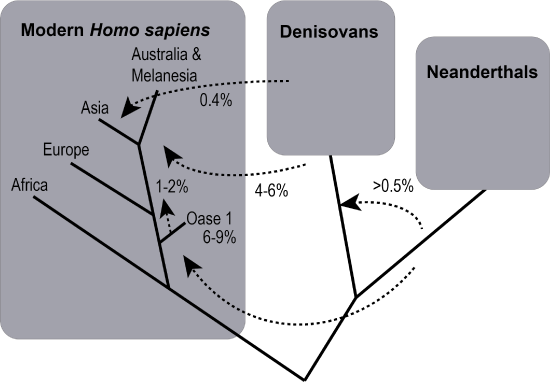 Figure \(\PageIndex{1}\): This diagram shows the amount of DNA introgression between Neanderthals, Denisovans, and various regional lineages of modern Homo sapiens. The 6–9% Neanderthal DNA found in the modern human Oase 1 was narrowed down to 1–2% in later modern humans. Denisovans share a few percent of their DNA with modern Australasians and Melanesians but just a fraction of a percent with modern East Asians.
Figure \(\PageIndex{1}\): This diagram shows the amount of DNA introgression between Neanderthals, Denisovans, and various regional lineages of modern Homo sapiens. The 6–9% Neanderthal DNA found in the modern human Oase 1 was narrowed down to 1–2% in later modern humans. Denisovans share a few percent of their DNA with modern Australasians and Melanesians but just a fraction of a percent with modern East Asians.Interbreeding with Neanderthals
Since the first finds of Neanderthal remains, researchers have sought evidence of a biological connection with modern Europeans. While there are no sites that show Neanderthals and modern Homo sapiens lived together (such as both types of skeletons found together in a common burial), interbreeding has been suggested by the appearance of Neanderthal traits in otherwise modern human skeletons found in their common geographical range. For example, the Oase 2 cranium from Peștera cu Oase and the Skhul V cranium each had a partial occipital bun between the Neanderthal and modern extremes.
A new source of evidence arrived with the invention of ancient DNA (aDNA) analysis, which has built up more evidence of Neanderthal and modern human interbreeding. DNA samples from Neanderthal fossils have been compared to DNA from both prehistoric and present-day modern Homo sapiens to trace the amount of gene flow between these groups. The amount of transfer is more indicative of introgression, the entrance of small, uneven portions of Neanderthal DNA into modern humans, rather than an even hybridization over time (Dannemann and Racimo 2018; Slatkin and Racimo 2016). The introgression could have been caused by an imbalance in population size: the continually growing modern population with gene flow from Africa could have diluted the incoming Neanderthal DNA to the low percentage seen today. The time spent apart as separate lineages could have caused genetic incompatibility, especially in the Y chromosome (Mendez et al. 2016). Natural selection may also have removed the inherited Neanderthal alleles if they were maladaptive, leaving just the adaptive or neutral variants.
Continuing DNA analyses reveal more details about interbreeding. Geneticist Fu Qiaomei and her team (2015) revealed long sections of Neanderthal DNA in Oase 1, around 6%–9% of the total amount, suggesting a Neanderthal ancestor four to six generations before. Fu also found continuous sections of Neanderthal DNA in the DNA of Russian and Siberian modern humans from around 45,000 years ago, reinforcing the genetic evidence of interbreeding (Fu et al. 2014).
The findings of Neanderthal DNA analysis and comparison with modern human genomes worldwide have revealed surprising details about the interactions between these groups. An unexpected result is that modern Asians have more DNA from Neanderthals than modern Europeans despite the separation in geography (Wall and Yoshihara Caldeira Brandt 2016). Today, non-Africans have around 1%–2% Neanderthal DNA in their genomes, with Asians having more than Europeans. This is a drop from the amount found in Oase 1. One explanation for this finding is that the interbreeding between Neanderthals and modern humans happened in the Middle East before the population split into the modern European and Asian populations. Then Neanderthal DNA introgressed at least a second time just into the Asian population, leaving more in that group.
Interbreeding with Denisovans
Comparison of DNA between the Denisovan archaic humans and modern humans has also produced intriguing information about the interaction between these groups. Denisovan DNA has also introgressed into some modern human populations (Reich et al. 2010; Reich et al. 2011). In this case, neither modern Africans nor Europeans have any Denisovan DNA. There is around 0.4% in modern East Asians. Notably, most modern Tibetans inherited a Denisovan allele that produces an adaptation to high-altitude living (Huerta-Sánchez et al. 2014). The highest amount is in some modern Melanesians and aboriginal Australians, between 4% and 6%. Though the Denisovan sample came from the Altai Mountains in Siberia, the most likely location for the interbreeding based on the DNA evidence was in East Asia or Sunda. The ancestors of the Melanesians and Australians would have received the Denisovan DNA into their genomes there before their descendants expanded to their eventual destinations.
Summary of Archaic Human Genetic Introgression
While the study of skeletal traits suggested archaic-modern interbreeding, the use of DNA analysis provided solid evidence of these events between archaic and modern Homo sapiens in Europe and Asia. This is a very active field as the technology keeps improving and more samples are analyzed. A consistent picture is forming, but many of the details concerning the timing and context of interbreeding are still unclear. At this point, we know that three human groups interbred with each other at different times. DNA originating from Neanderthals and Denisovans was found in prehistoric modern humans and is present in some Europeans and Asians of today. The introgressed DNA has affected the traits of our own species and they are just being discovered.
African Developments
We now switch our view back to Africa to see what developments occurred after members of our species first crossed to the Middle East and beyond. Our survey of modern Homo sapiens expansion left Africa around 150,000 years ago to see where people pushed the fringes of our geographical range. It is important to remember the species did not all leave Africa together. While modern humans found ways to survive in the Middle East, Asia, Sahul, and Europe, many others remained in Africa. Evidence of what Homo sapiens did in Africa from the end of the Middle Stone Age to the Later Stone Age is concentrated in South African sites. There, Blombos Cave and Border Cave show that complex human behavior was also developing in the home continent.
Blombos Cave is located along the present shore of the Cape of Africa facing the Indian Ocean and is notable for having a wide variety of artifacts. The material culture shows that toolmaking and artistry were more complex than previously thought for the Middle Stone Age. Excavations and analysis have been carried out since the 1990s by a research team including Francesco d’Errico, Christopher Henshilwood, and Marian Vanhaeren. In a layer dated to 100,000 years ago, researchers found two intact ochre-processing kits made of abalone shells and grinding stones (Henshilwood et al. 2011). Chemical analysis found the likely ingredients of the ochre-based paint, including crushed bone, animal fat, and charcoal. More ochre fragments, including some marked with notches, were found all throughout the site. The team performed numerous analyses and experiments to show that perforated marine snail shell beads from 75,000 years ago were shaped by people using bone points found in the cave (Figure 12.19) (d’Errico et al. 2005). Together, the evidence shows that the Middle Stone Age occupation at Blombos Cave incorporated resources from a variety of local environments into their culture, from caves (ochre), open land (animal bones and fat), and the sea (abalone and snail shells). This complexity shows a deep knowledge of the region’s resources and their use—not just for survival but also for symbolic purposes.
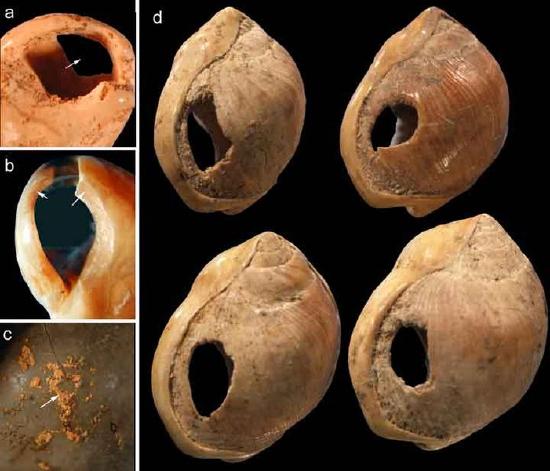 Figure \(\PageIndex{2}\): Examples of the perforated shell beads found in Blombos Cave, South Africa: (a) view of carved hole seen from the inside; (b) arrows indicate worn surfaces due to repetitive contact with other objects, such as with other beads or a connecting string; (c) traces of ochre; and (d) four shell beads showing a consistent pattern of perforation.
Figure \(\PageIndex{2}\): Examples of the perforated shell beads found in Blombos Cave, South Africa: (a) view of carved hole seen from the inside; (b) arrows indicate worn surfaces due to repetitive contact with other objects, such as with other beads or a connecting string; (c) traces of ochre; and (d) four shell beads showing a consistent pattern of perforation.On the eastern coast of South Africa, Border Cave shows new African cultural developments at the start of the Later Stone Age. Paola Villa and colleagues (2012) identified several changes in technology around 43,000 years ago. Stone tool production transitioned from a slower, measured process to one that took less time to finish but made many microliths, small stone tools. An adhesive made from tree bark was found on some of the microliths. The researchers hypothesize that hunting technology moved from large crafted spearheads to smaller bone arrow points that were adhered to shafts and even tipped with poison for more effectiveness. Changes in decorations were also found across the Later Stone Age transition. Beads were made from a new resource: fragments of ostrich eggs (d’Errico et al. 2012). Unlike the snail shell beads, which retained the shape of the original structure, ostrich shell beads were shaped into circular forms, resembling present-day breakfast cereal O’s. While a subtle difference, these beads show a higher level of altering one’s own surroundings and a move from the natural to the abstract in terms of design.
Summary of Continuing Modern H. sapiens in Africa
African culture experienced a long constant phase called the Middle Stone Age until a faster burst of change produced innovation and new styles. The change was not one moment but rather a ramping up in development. Later Stone Age culture introduced elements seen across many cultures, including the construction of composite tools and even the use of strung decorations such as beads. These developments appear in the Later Stone Age of other regions, such as with the Balangoda of Sri Lanka and the Aurignacian tradition of Europe, both mentioned above. Based on the early date of the African artifacts, Later Stone Age culture may have originated in Africa and passed from person to person and region to region, with people adapting the general technique to their local resources and viewing the meaning in their own way.
Unfortunately, information about modern humans in Africa from 40,000 to 12,000 years ago is scarce. In the next section, we will return to the expanding frontier as the first hominins set foot in the Western Hemisphere.
Discovering the Americas
By 20,000 years ago, our species was the only member of Homo left on Earth. Gone were the Neanderthals, Denisovans, and Homo floresiensis. The range of modern Homo sapiens kept expanding eastward into—using the name given to this area by Europeans much later—the Western Hemisphere. This section will address what we know about the peopling of the Americas, from the first entry to these continents to the rapid spread of prehistoric Native Americans (referred to by researchers without intentional insult as prehistoric Amerindians, Paleoindians, or Paleoamericans) across its lush and varied environments.
The Changing Role of Beringia
Evidence points to a prehistoric land bridge called Beringia that allowed people to cross from Asia to North America, just as expansion to Australia was made easier with lowered sea levels that exposed Sunda and Sahul. Beringia connected what is now northeastern Siberia with Alaska. What people did to cross this land bridge is still being investigated. Currently there are two competing models for this event, called the and the Coastal Route model, though the latter has been gaining intriguing evidence.
For most of the 20th century, the accepted theory was that prehistoric northeast Asians (East Asians and Siberians) first expanded across Beringia inland through an ice-free corridor between glaciers that opened into the western Great Plains of the United States, just east of the Rocky Mountains, around 13,000 years ago (Swisher et al. 2013). While life up north in the cold environment would have been harsh, migrating birds and an emerging forest might have provided sustenance as generations expanded through this land (Potter et al. 2018). These residents would have used a stone tool style that developed into the common Clovis style found later in North America.
In recent decades, researchers accumulated evidence against the ice-free corridor as the original path the first Native Americans took. For example, some archaeological sites around the Americas date to a time before the corridor was open. While one site with a date that contradicts the model could be dismissed as an error at first, several more sites were found that brought more scrutiny to the Ice-Free Corridor model. The route between glaciers was available later, and was likely used at that time, but there was already a more accessible path between the hemispheres.
The reconstruction of past geography, climate, and ecology led to the formation of the Coastal Route model that explains how people reached the Americas through Beringia. The new focus is the southern edge of the land bridge instead of its center: About 16,000 years ago, members of our species expanded along the coastline from northeast Asia, east through Beringia, and south down the Pacific Coast of North America while the inland was still sealed off by ice. Archaeologist K. R. Fladmark (1979) brought the Coastal Route model into the archaeological spotlight and researcher Jon M. Erlandson has been at the forefront of compiling support for this theory (Erlandson et al. 2015). Reconstructing the geography and climate of Beringia, the coast would have been free of ice at least part of the year by 16,000 years ago, earlier than when the ice-free corridor was completely opened. Studies of past ecology found that the coastal route would have provided abundant plant and animal resources for most of the path. Besides migrating birds, many useful fish (e.g., salmon), shellfish, mammals (e.g., whales, seals, and otters), and plants (e.g., seaweed) would have been available on the coast. A refinement of this model called the Kelp Highway hypothesis focuses on one particular ecosystem found just offshore from Japan, north to Beringia, and south to Baja California. This addition states that subsisting off of resources from kelp forests could have supported the rapid expansion to the Americas and down the coast of the two continents.
Other lines of evidence are also compatible with the Coastal Migration model. One indirect archaeological connection between prehistoric Japan and the Americas is a certain style of stone tool. Coastal tanged or stemmed lithics, which are stone points with a thin projection at the base, have been found in both of these distant regions (Erlandson and Braje 2011). The similarity could indicate a cultural tie. Genetic analysis of Native American DNA also shows shared ancestry with northeast Asians, linking them biologically as well (Raghavan et al. 2014).
While many factors such as reconstructions of climate and ecology indirectly support the Coastal Migration model, the search continues for direct evidence such as archaeological sites along the route. Due to the warming trend since 18,000 years ago that reduced glaciers and raised the sea level, much of the prehistoric coast that would have been occupied by the first coastal migrants to North America is currently over 100 meters underwater (Erlandson et al. 2015).
Researchers are also still determining how many large waves of people made the crossing through either Beringian route. A four-field analysis of modern Native American languages found evidence of three migration events, resulting in three major language groups (Greenberg 1987). Analyzing the DNA of prehistoric and modern peoples, which was not possible in Greenberg’s time, researchers found evidence for one large wave of gene flow from Beringia, with major splits once in North America (Raghavan et al. 2015). Smaller waves after the main one could also have moved from Beringia to North America. As far back as 23,000 years ago, people living in Beringia would have had lowered gene flow with northeast Asians and also been unable to expand further east. This concept of a period of genetic isolation based on DNA analysis is called the Beringia Standstill Model. It explains the amount of genetic differences between Native Americans and northeast Asians within the time frame of the other evidence.
South through the Americas
However the first modern Homo sapiens reached the Western Hemisphere, the spread through the Americas was rapid. Multiple migration waves crossed from North to South America (Posth et al. 2018). Our species took advantage of the lack of hominin competition and the bountiful resources both along the coasts and inland. The Americas had their own wide array of megafauna, which included woolly mammoths, mastodons, camels, horses, ground sloths, giant tortoises, and—a favorite of researchers—a two-meter-tall beaver (Figure 12.20). The reason we cannot find these amazing animals today may be that ancient Native Americans hunted them all to extinction. Resources gained from these fauna must have been an important part of survival for people over 12,000 years ago (Araujo et al. 2017). Several sites are notable for what they add to our understanding of American prehistory, including interactions with megafauna and other elements of the environment.
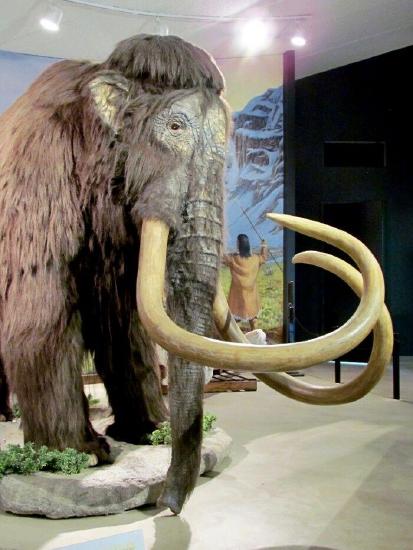 Figure \(\PageIndex{3}\): Lifesize reconstruction of a woolly mammoth at the Page Museum, part of the La Brea Tar Pits complex in Los Angeles, California. Outside of Africa, megafauna such as this went extinct around the time that humans entered their range.
Figure \(\PageIndex{3}\): Lifesize reconstruction of a woolly mammoth at the Page Museum, part of the La Brea Tar Pits complex in Los Angeles, California. Outside of Africa, megafauna such as this went extinct around the time that humans entered their range.Monte Verde is a landmark site that shows that the human population had expanded down the whole vertical stretch of the Americas to Chile by 14,600 years ago, only a few thousand years after humans first entered the Western Hemisphere from Alaska. The site has been excavated by archaeologist Tom D. Dillehay and his team (2015), revealing fragile material culture that is rarely preserved, including human footprints, animal hides, and wooden tools. Two of the discoveries at Monte Verde relate to the Coastal Migration model. The discovery of nine edible species of seaweed at the site shows familiarity with coastal resources that might have been passed down through generations of experience living near the ocean. A stemmed point, reminiscent of the coastal styles, was also among the lithics at Monte Verde (Figure 12.21).
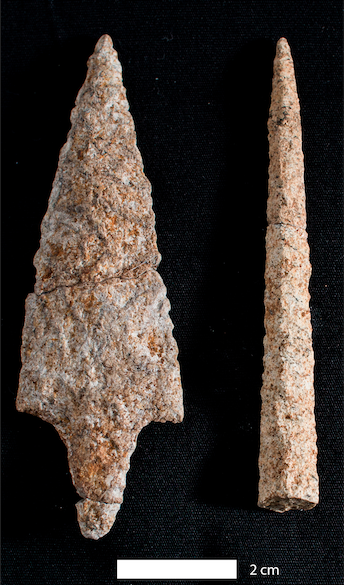 Figure \(\PageIndex{4}\): A stemmed point (left) and drill fragment (right) found in the same level at Monte Verde. The stemmed point resembles a coastal Andean style called the Paiján and may be evidence supporting the Coastal Route model.
Figure \(\PageIndex{4}\): A stemmed point (left) and drill fragment (right) found in the same level at Monte Verde. The stemmed point resembles a coastal Andean style called the Paiján and may be evidence supporting the Coastal Route model.Named after the town in New Mexico, the Clovis stone tool style is the first example of a widespread culture across much of North America, between 13,400 and 12,700 years ago (Miller, Holliday, and Bright 2013). Instead of a stem-shaped base, Clovis points were fluted with two small projections, one on each end of the base, facing away from the head (Figure 12.22). The stone points found at this site match those found as far as the Canadian border and northern Mexico, and from the west coast to the east coast of the United States. Fourteen Clovis sites also contained the remains of mammoths or mastodons, suggesting that hunting megafauna with these points was an important part of life for the Clovis people. Other Clovis sites show that other types of hunting and gathering were important to people’s subsistence, too. After the spread of the Clovis style, it diversified into several regional styles, keeping some of the Clovis form but also developing their own unique touches.
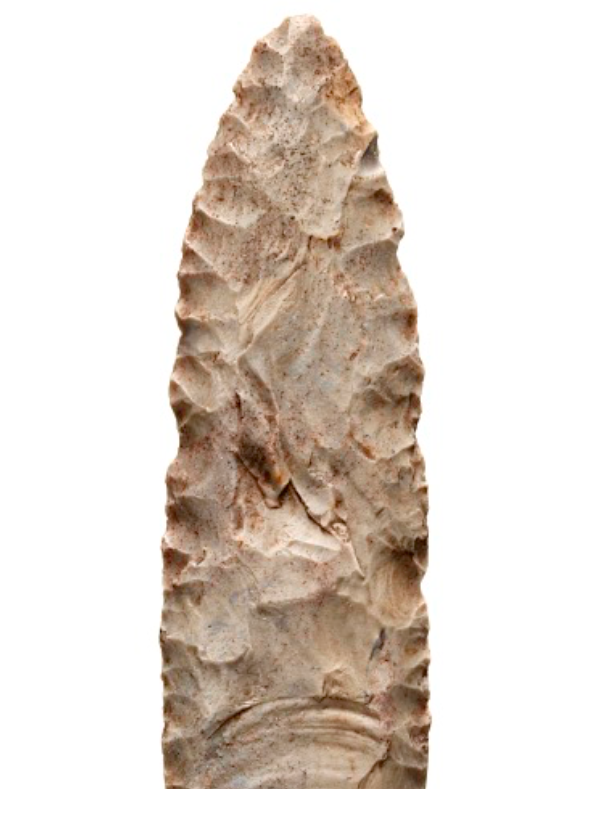 Figure \(\PageIndex{5}\): Compared to the stemmed point in Figure 12.21, this Clovis point has a drastically different structure. The Clovis point has a wider tip and the base has two small projections instead of a single large stem. This example was carved from chert and found in north central Ohio, dated to around 11 kya.
Figure \(\PageIndex{5}\): Compared to the stemmed point in Figure 12.21, this Clovis point has a drastically different structure. The Clovis point has a wider tip and the base has two small projections instead of a single large stem. This example was carved from chert and found in north central Ohio, dated to around 11 kya.Only one site has a human burial containing Clovis tools: Anzick in western Montana. The individual, Anzick-1, is a male infant dated to 12,800 years ago (Rasmussen et al. 2014). He was buried with over 100 Clovis stone and bone tools that were coated in ochre. Genetic analysis found that Anzick-1’s people were related to all later Native Americans, proving a direct ancestral connection and supporting the model of one large wave of migrants populating the Americas with ancient humans.
Summary of Modern H. sapiens in the Americas
Research in prehistoric Native American origins found some surprising details, refining older models. Genetically, the migration can be considered one long period of movement, with splits into regional populations. This finding matches the sudden appearance of the homegrown Clovis culture, its rapid expansion, and the radiation of descendant cultures in North America. A few thousand years after arrival into the hemisphere, people had already covered the Americas from north to south.
The peopling of the Americas also had a lot of common elements with the prior spread of humans across Africa, Europe, Asia, and Australia. In all of these expansions, people explored new lands that tested both the cultural and biological adaptations of the pioneers. Besides stone tool technology, the use of ochre as decoration was seen from South Africa to South America. The coasts and rivers were likely avenues in the movement of people, artifacts, and ideas, outlining the land masses while providing access to varied environments. The presence of megafauna aided human success, but this resource was eventually depleted in many parts of the world.
With our tracing of human expansion across the continents complete, we will see how researchers visualize what we learned about the origin and dispersal of modern Homo sapiens from 315,000 to 12,000 years ago.
The Big Picture: The Assimilation Model
How do researchers make sense of all of these modern Homo sapiens discoveries that cover over 300,000 years of time and stretch across every continent except Antarctica? How was modern Homo sapiens related to archaic Homo sapiens? Over the past few decades, paleoanthropologists have engaged in spirited debates based on their interpretation of the data. In the mid- to late 20th century, scientists had split into two competing views. This section describes this episode of paleoanthropology history and how continuing scientific research improves our view of the world.
One competing model was called the Out of Africa model or Recent African Origin model. Supporters of this model saw evidence that modern Homo sapiens first evolved in Africa, then expanded into the other continents without interaction with the archaic Homo sapiens of Europe and Asia (Stringer and Andrews 1988). Researchers on this side noted that the oldest modern Homo sapiens fossils were found in Africa, suggesting that that continent was the origin. Genetic analysis found the same conclusion.
The other model was called Multiregionalism or the Multiregional Continuity model. The view of the data by scientists on this side was that modern Homo sapiens evolved from the archaic humans in Africa, Europe, and Asia simultaneously (Wolpoff 1989). Gene flow would have kept the species cohesive across the great distance while producing local variation as well. The multiregionalist experts pointed to the sharing of traits from Homo erectus, through archaic Homo sapiens, and then to the modern humans in different parts of the world as supporting their model. For example, in Europe the Oase modern humans possessed Neanderthal-like traits and certain modern humans possess alleles that came from Neanderthals and Denisovans.
Eventually, researchers noticed that both the Out of Africa model and the Multiregionalism model had elements that were supported by data and elements that were not supported. Taking the supported parts of each model and combining them formed an explanation that was more complicated, but explained much more of the scientific evidence. The merging of two models to form a better one suits the name of the improved version: the Assimilation model.
The Assimilation model proposes that modern Homo sapiens evolved in Africa first and expanded out (from the Out of Africa model) but also interbred with the archaic Homo sapiens they encountered outside Africa (from the Multiregionalism model) (Figure 12.23). True multiregionalism occurred just within Africa as the species evolved from a web of interactions between varied groups (Scerri et al. 2018). As the modern human population expanded from Africa, they assimilated the alleles of archaic humans they encountered through interbreeding. The Assimilation model is powerful since it explains why Africa has the oldest modern human fossils, why early modern humans found in Europe and Asia bear a resemblance to the regional archaics, and why traces of archaic DNA can be found in our genomes today (Smith et al. 2017).
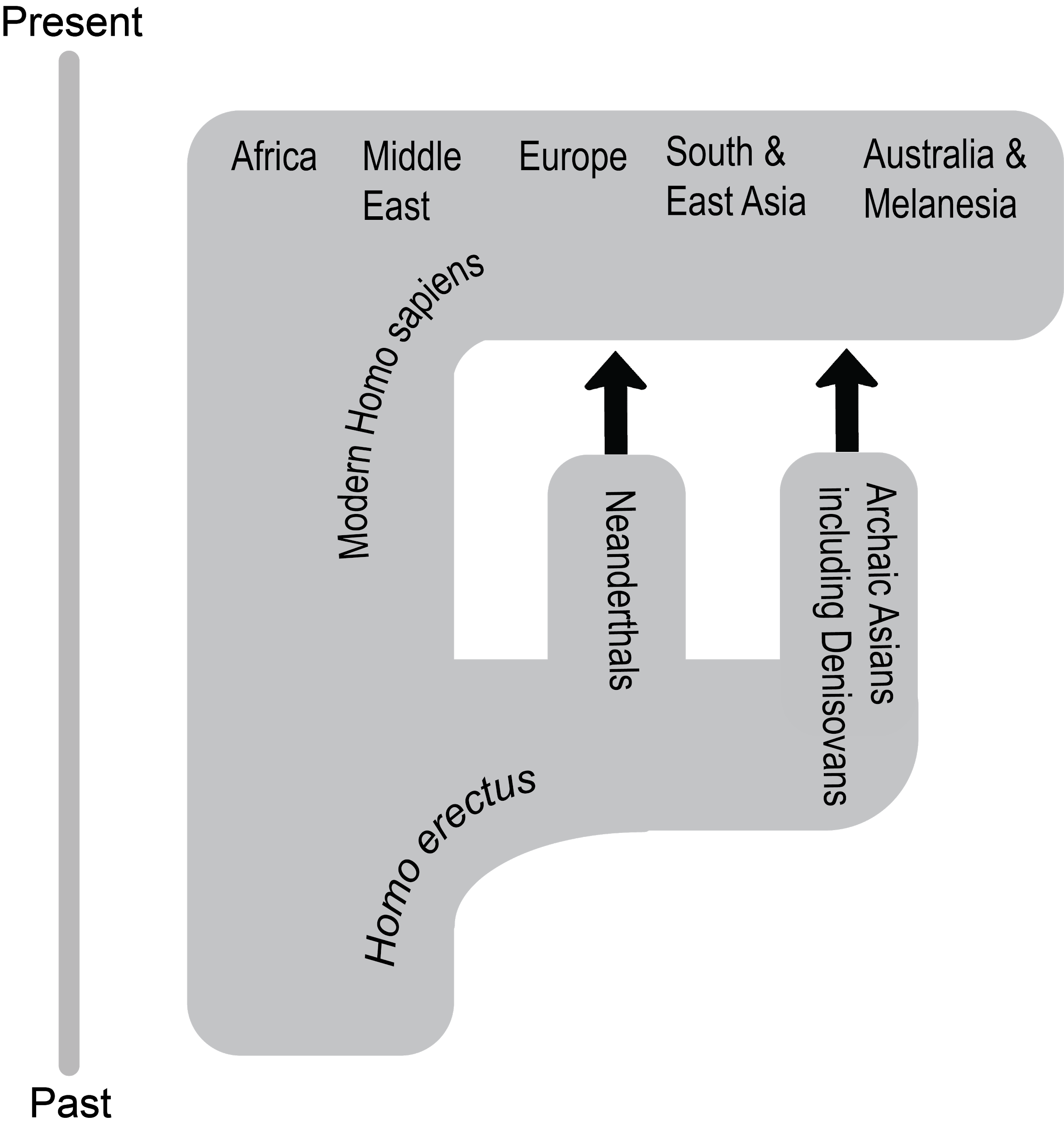 Figure \(\PageIndex{6}\): This diagram depicts the connections between archaic and modern Homo sapiens of different regions. Having evolved from Homo erectus, the archaic humans expanded from Africa and established the Neanderthal and Denisovan groups. In Africa, the remaining archaic humans evolved the modern set of traits and expanded from the continent as well, encountering and interbreeding with two archaic groups across Europe and Asia.
Figure \(\PageIndex{6}\): This diagram depicts the connections between archaic and modern Homo sapiens of different regions. Having evolved from Homo erectus, the archaic humans expanded from Africa and established the Neanderthal and Denisovan groups. In Africa, the remaining archaic humans evolved the modern set of traits and expanded from the continent as well, encountering and interbreeding with two archaic groups across Europe and Asia.While scientific progress has produced a model that satisfies the data, there are still a lot of questions for paleoanthropologists to answer regarding our origins. What were the patterns of migration in each part of the world? Why did the archaic humans go extinct? In what ways did archaic and modern humans interact? How large were the past populations? How did biological, cultural, and environmental factors influence the material culture found in different parts of the world? The definitive explanation of how our species started and what our ancestors did is still out there to be found. You are now in a great place to welcome the next discovery about our distant past—maybe you’ll even contribute to our understanding as well.
Special Topics: “Cavemen” in Popular Culture
“Cavemen,” or our prehistory in general, is a constant presence in western popular culture. From the iconic opening to 2001: A Space Odyssey to the less iconic 10,000 B.C., the distant past is a common setting for dramatic stories. The prehistoric experience even gets interactive with games like Far Cry Primal where the player can persistence-hunt for food and ride a woolly mammoth (!) (Figure 12.24). The distant past has also been the setting for more comedic stories, such as The Flintstones and, recently, The Croods with Nicolas Cage.
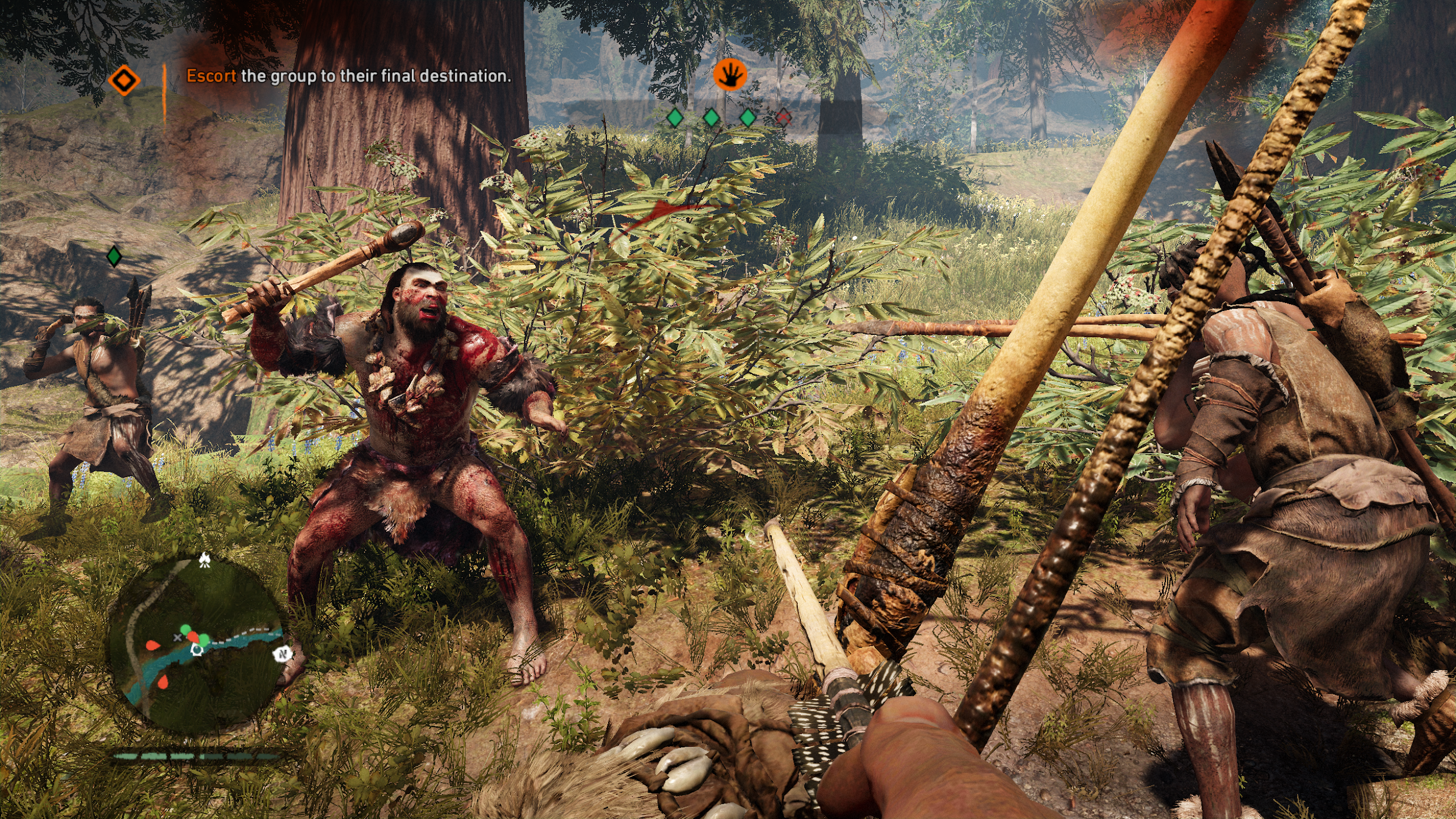 Figure \(\PageIndex{7}\): Screenshot of an action scene from the videogame Far Cry Primal. While the game is set at 12 kya, one faction of humans has distinctly Neanderthal traits (center-left), though none were left by that time in reality. Note touches inspired by research, such as the use of shells for decoration on the protagonist’s wrist.
Figure \(\PageIndex{7}\): Screenshot of an action scene from the videogame Far Cry Primal. While the game is set at 12 kya, one faction of humans has distinctly Neanderthal traits (center-left), though none were left by that time in reality. Note touches inspired by research, such as the use of shells for decoration on the protagonist’s wrist.Why are we interested in the past beyond a scientific understanding? Like feudal times or the Wild West, prehistory may be a setting that is rife for telling stories that excite us. With humanity stripped of the modern conveniences we are used to, situations become more intense. Prehistory takes this trope to the extreme. The viewer/game player is invited to think about what they would do if they had to live more directly off of the environment, unshielded from the dangers of the natural world. Experiencing our imaginings of that time may satisfy parts of our brain that evolved in that situation, just as people accustomed to urban life find enjoyment by camping or sitting around a fire with friends and family. Seeing the portrayal of the prehistoric world may reach those parts of our psychology that feel at home away from our constructed environment.
That said, the portrayal of the past in fiction is rarely accurate. There is a significant lag time between the scientific view of our past and when it reaches mass media. Older works age very poorly. In Clan of the Cave Bear, a book from 1980, the Neanderthals have limited emotions and communicate with sign language rather than speaking: two ideas that have not stood the test of time but were core to the story. Even in recent productions, prehistoric people are dim-witted and have limited vocabulary, though the evidence shows that our brains and language abilities are basically the same today as 300,000 years ago. How our media choose to represent the past may say more about our own values and views of ourselves rather than what people were actually like long ago.
As you engage in the next fiction set in our distant past, consider how the presentation differs from the scientific view and why there is this divide. Also, as you enjoy the world that is presented to you, consider that we are not so different from the cavemen. We are the ones born into the world of projectors and streaming media, and we may build on that to create the next medium, but at our core we are the same as the painters of Lascaux and the carvers of prehistoric figurines.

